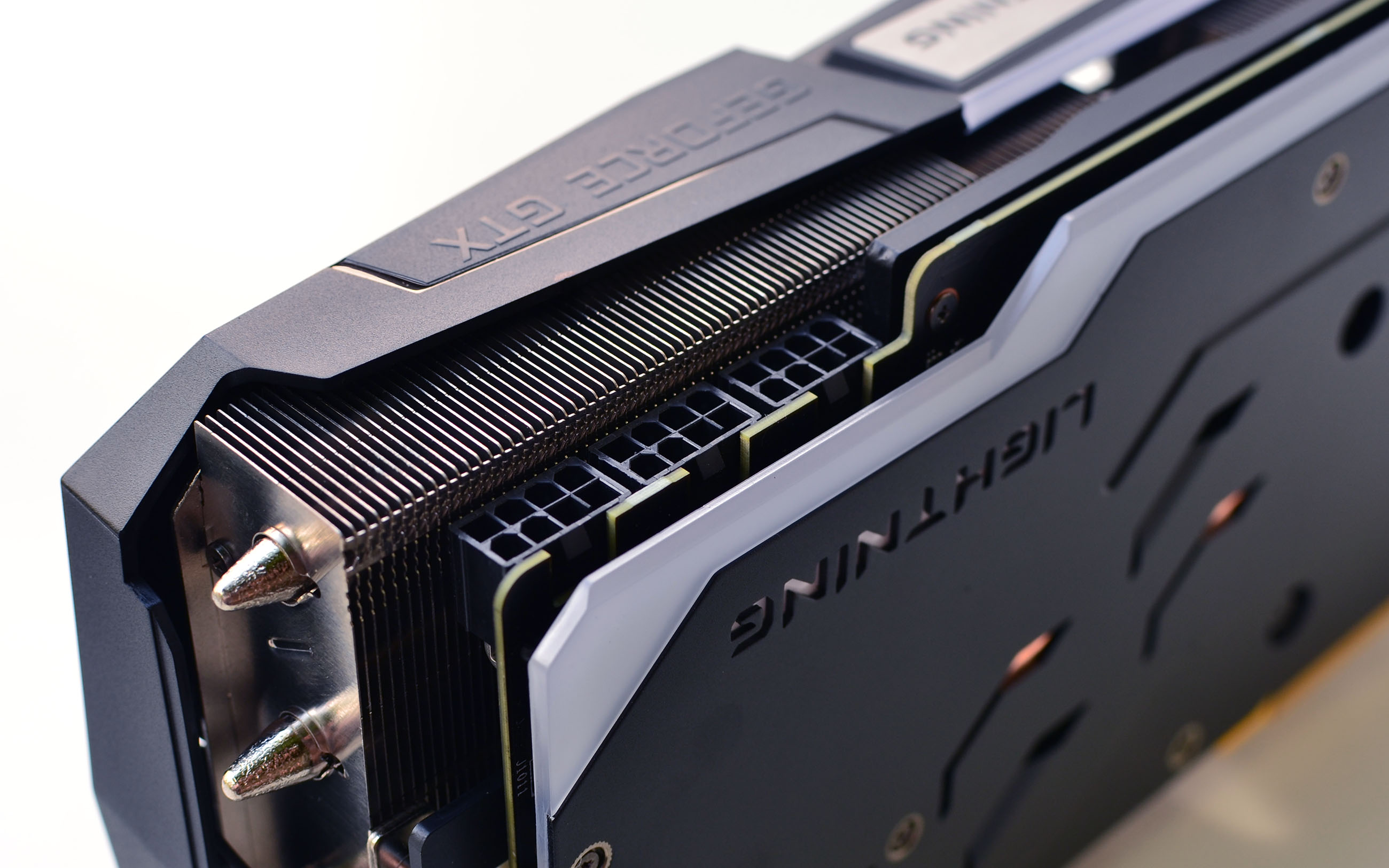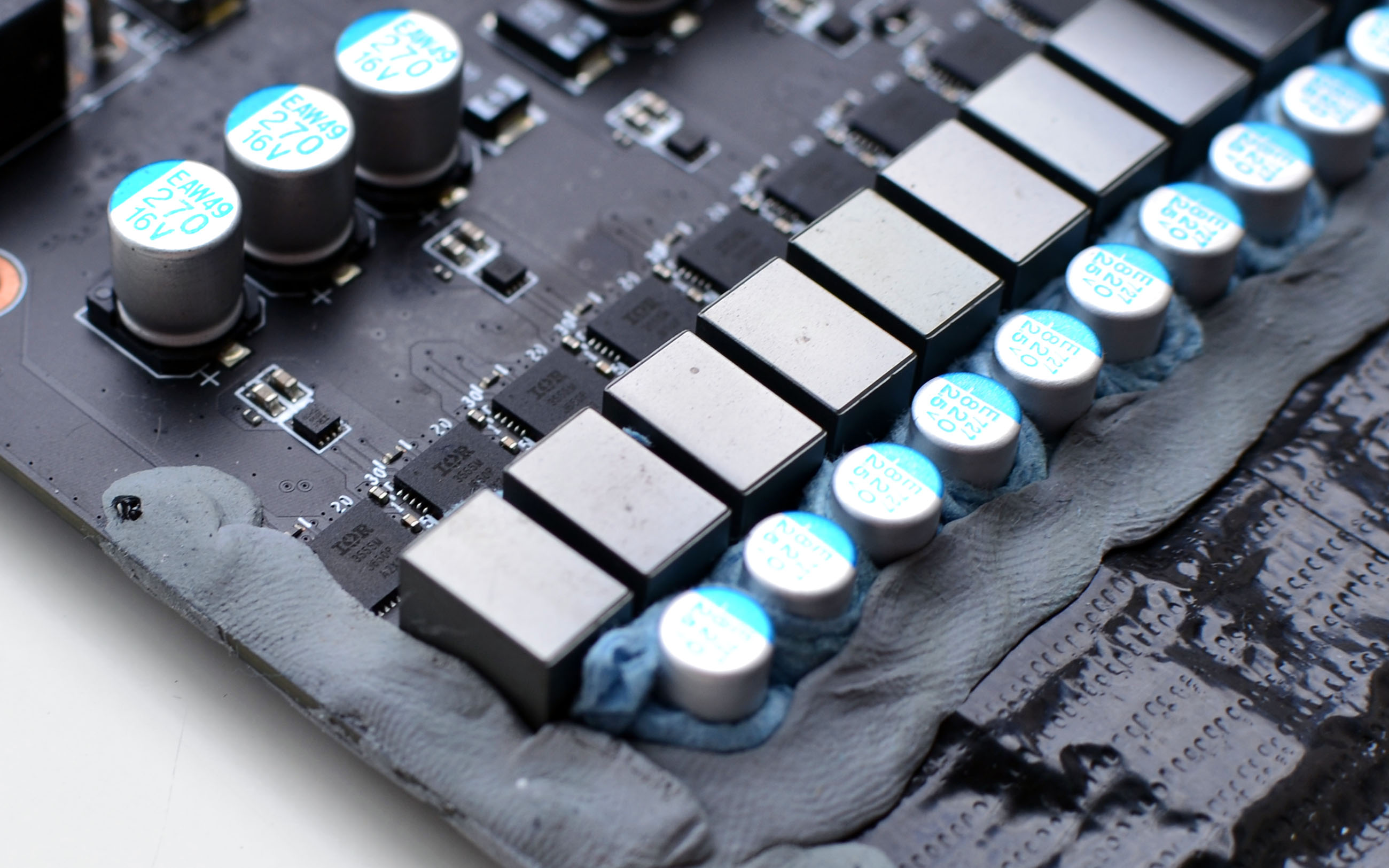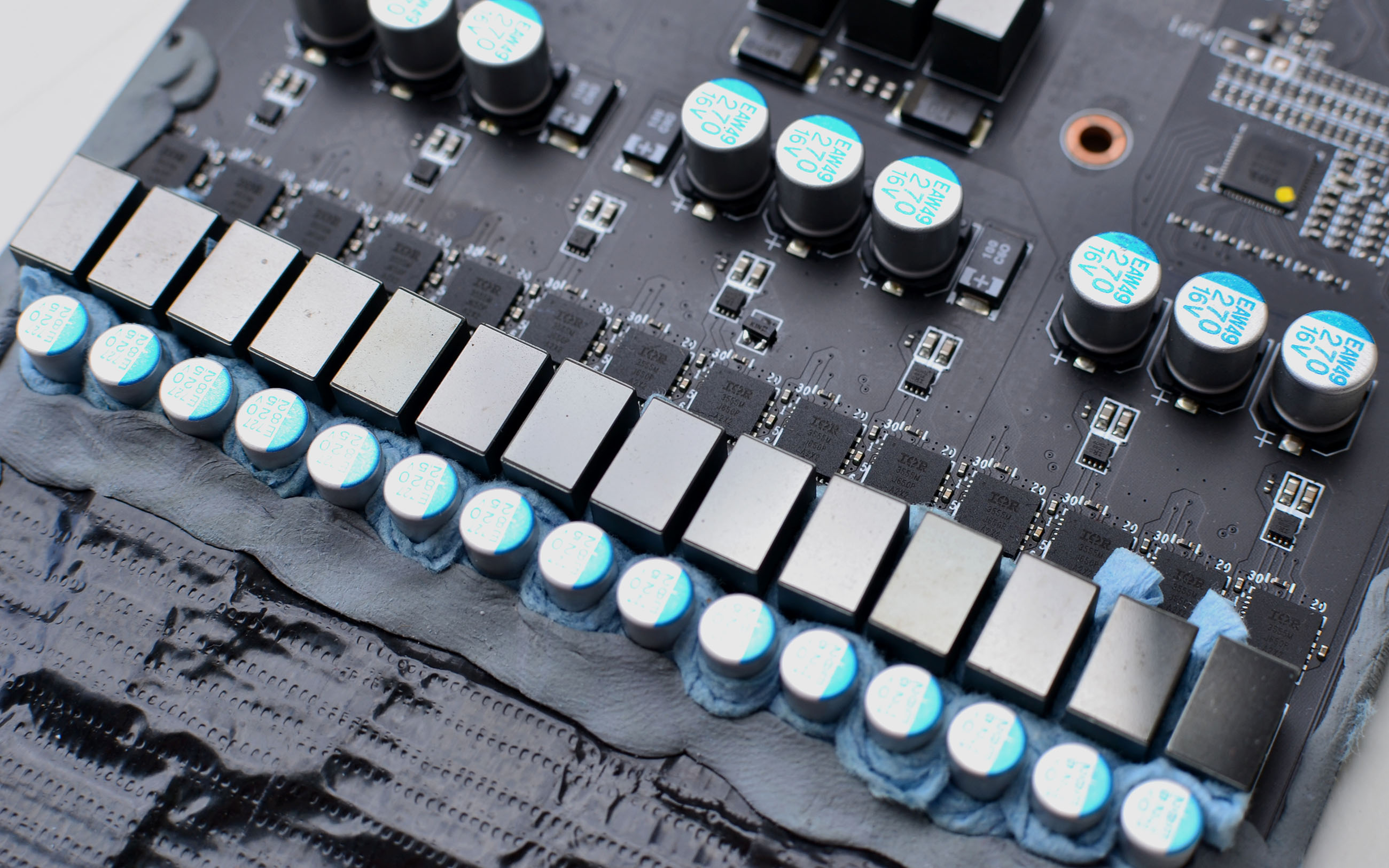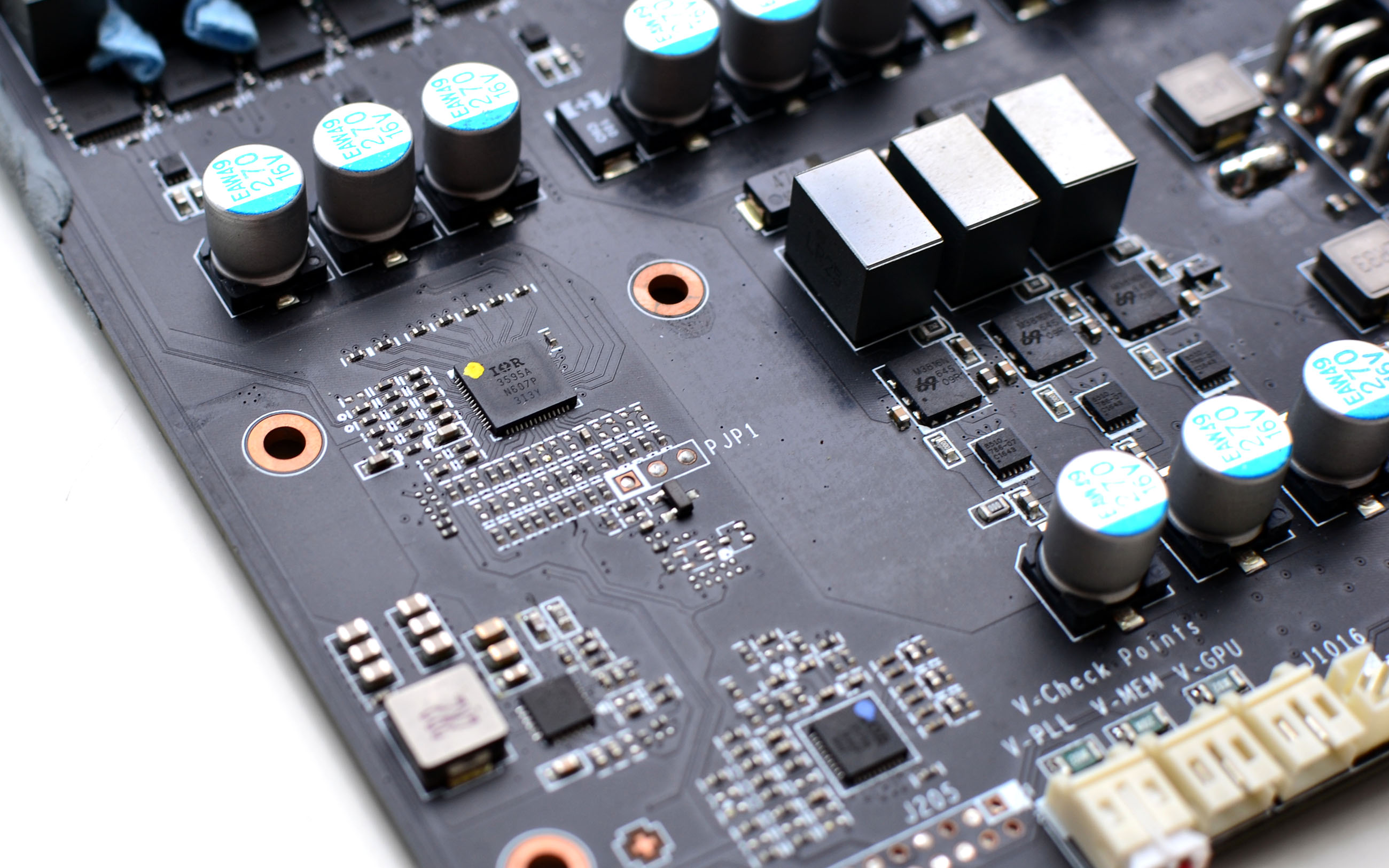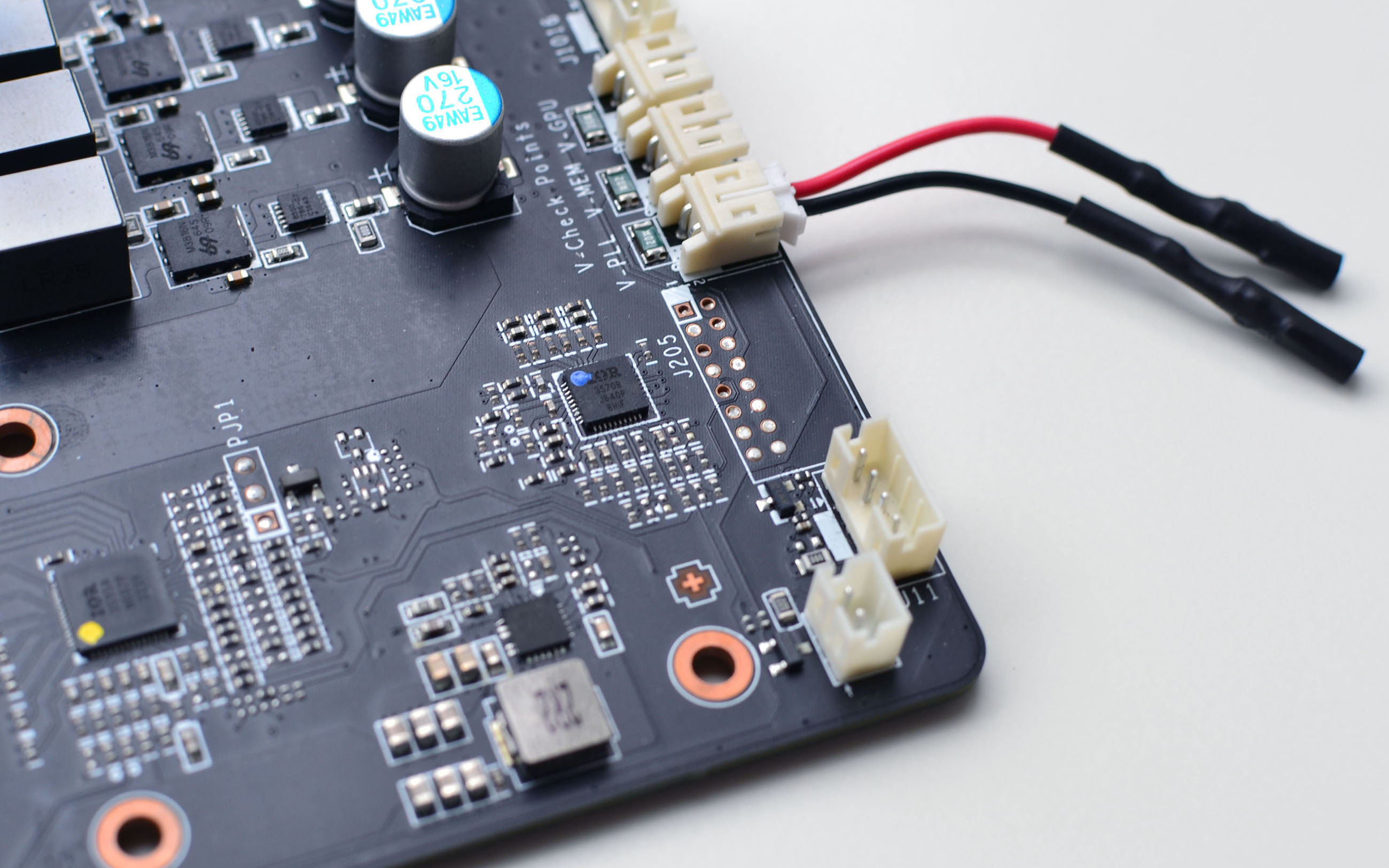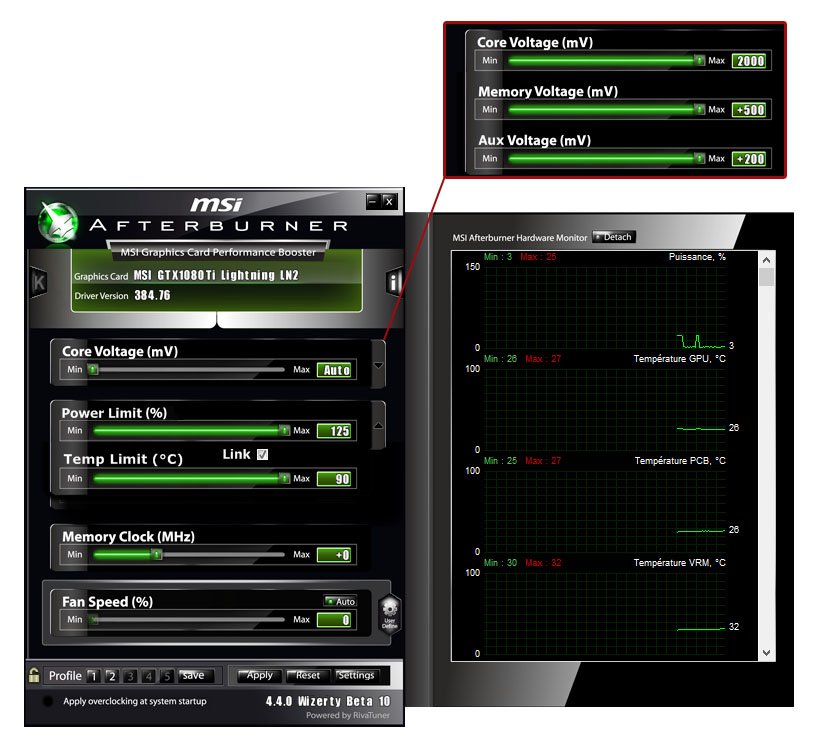GeForce GTX 1080 Ti At 2.5 GHz+: Overclocking On Air, Water, And LN2
A Heavy-Hitting Power Supply
Beyond the heat sinks and backplate, MSI also doesn't skimp on power delivery. Its engineers used some of the best components available. Despite our extreme experimentation, we simply were not able to trigger any of this card's protection features.
Power: A Trio of Eight-Pin Auxiliary Connectors
MSI's card is powered through three eight-pin auxiliary connectors and its 16-lane PCIe slot. Most GeForce GTX 1080 Tis employ two; why does this one need three?
During normal use, even if you're overclocking, the third connector is completely useless. But when the tuning gets extreme, this card's power consumption jumps through the roof. Dynamic power is defined as P = CV2f, where V is voltage and f is frequency. So, as you might imagine, increasing V has a much bigger effect on P than f. Using certain settings, we have seen spikes beyond 1000W for just the graphics card. You can imagine that, under those conditions, the supplementary connector is a welcome addition. It also reduces the load placed on each cable. By using three connectors instead of two, the wires heat up less. And in the case of a multi-rail power supply, this offers more flexibility for distributing load.
The GPU Power Supply
Arming a card with extra connectors is only helpful if the voltage regulation circuitry can keep up. MSI equips the GeForce GTX 1080 Ti Lightning Z with seven power phases for its GP102 processor, doubled using IR3599s. International Rectifier IR3555Ms handle the conversion from 12V to lower output voltages, integrating the high- and low-side MOSFETs and Schottky diode.
Each of these ICs supports an output current of up to 60A. A quick calculation tells us that two 60A VRMs per phase times seven phases is a maximum of 840A. That's in theory, at least. These VRMs are doubled, so they'll never have to handle 60A. And even after extreme overclocking, the power supply will always incur losses due to heat dissipation and resistance. According to our estimates, we never went above the ~700A range during our most hardcore torture testing.
Again, in theory, with a supply voltage of 1.5V, we arrive at a maximum power consumption of 1260W. Knowing that the 60A rating is for continuous usage, and that the real maximum limit is much higher, we can safely proceed before applying the liquid nitrogen.
International Rectifier's IR3595A, marked with a yellow dot in the image above, controls the power hardware, enabling up to eight phases. It protects the card in multiple ways:
Get Tom's Hardware's best news and in-depth reviews, straight to your inbox.
- OVP and UVP in case the supply voltage is too high or too low.
- OC Warn and OCP, which warns and protects if the current is too high.
- OT Warn and TP, which warns and protects if the temperature gets too high.
A signal sent by the controller arrives at the aforementioned IR3599s, which dispatch it to the two VRMs per phase. These 14 phases are, therefore, really seven doubled phases. This method is commonly used to increase the reliability of a power phase.
We've become accustomed to seeing manufacturers count all of the supply rails as independent phases for marketing purposes. But really, in this case, it's more correct to say seven phases and 14 supply rails.
The Memory Power Supply
The GDDR5X also needs power. Even though this may seem to be of secondary importance, a stable supply is critical for attaining high memory frequencies. Therefore, MSI dedicates three phases to the modules on its GeForce GTX 1080 Ti Lightning Z. This time, we're really talking about three power phases; no doubling is used.
Equipped with UBIQ QM3816N6 dual N-channel trench MOSFETs, MSI's card runs no risk of lacking current.
Similar to the GPU's power supply, the memory needs a controller. A lower phase count calls for fewer inputs and outputs, though. In the following photo, International Rectifier's 3+2-phase IR3570B PWM controller is shown with a blue dot on it.
Special BIOS and Afterburner Extreme
Boasting a power supply able to strain a nuclear reactor is all well and good, but you have to be able to fully utilize it. That's tough, since Nvidia imposes a number of limitations on its manufacturing partners. However, there's a version of Afterburner out there free of those constraints. Sadly, MSI isn't able to publish it publicly; only extreme overclockers have access to it.
With 2V available to the graphics processor and +500mV for the GDDR5X, this card's maximum frequencies shouldn't be limited by either parameter.
In our screen shot, Power Limit (%) is adjustable up to 125%. But extreme BIOSes allow you to go even further with the Power Limit completely disabled.
MORE Best Graphics Cards
MORE: Overclocking GeForce GTX 1080 Ti To 2.1 GHz Using Water
MORE: How To: Optimizing Your Graphics Card's Cooling
Current page: A Heavy-Hitting Power Supply
Prev Page Meet MSI's GeForce GTX 1080 Ti Lightning Z Next Page Overclocking Under Air Cooling-
blppt Probably the EVGA FTW3 ELITE GAMING or Kingpin model (also perpetually unavailable). Thats all I can think of off the top of my head.Reply -
reimanrules Sorry if I come up as ignorant, can you tell me what PCA stands for? Thanks in advance.Reply -
Defekter_Engel I wonder if anyone has tried a closed loop LN2 circuit. Would keep it from changing state from liquid to gas. Downside being it would take a butt-ton of equipment.Reply -
TJ Hooker @reimanrules pretty sure PCA = printed circuit assemblyReply
@Defekter_Engel it's the boiling (i.e. changing state from liquid to gas) of the LN2 that keeps it cold. Also, trying to keep it liquid would result in extreme pressure building up. -
Tim_124 Vanilla 1080ti’s get to 2050mhz under air, and 2050-2100mhz under water. I’ve read reviews of lots of top of the line 1080ti’s and have yet to see any cards improve on stock performance. Unless the acoustics of the cooling solution are superior there is absolutely no benefit to any of these high end cards. GP102 is the undisputed king of GPU’s, but it doesn’t appear to benefit at all from enhanced power delivery systems. Not worth spending any money on them.Reply -
nitrium Reply
Wouldn't work. Liquid nitrogen is only cold when it is allowed to evaporate. In a closed loop it actually wouldn't be cold anymore at all - it would simply be at room temperature but with 2200 psi of pressure. Water is far more effective at transferring heat than liquefied (under pressure) nitrogen gas.20443483 said:I wonder if anyone has tried a closed loop LN2 circuit. Would keep it from changing state from liquid to gas. Downside being it would take a butt-ton of equipment.
-
derekullo Evaporation is endothermic.Reply
Condensation is exothermic.
Staying the same is thermally neutral.
Condensing room temperature nitrogen gas to liquid would be an exothermic phase change. (This is what you pay for when buying LN2. Nitrogen gas itself is quite literally all around you, although with some "impurities" like oxygen.)
Pouring your liquid LN2 into an area with standard atmospheric pressure allows the liquid to evaporate and expand.
The ideal gas law states that when a gas expands it also becomes cooler.
On the opposing side when a gas is compressed it becomes hotter.
(This heat is what supplies our sun with the temperatures necessary for nuclear fusion.) -
redgarl Reply20443319 said:Probably the EVGA FTW3 ELITE GAMING or Kingpin model (also perpetually unavailable). Thats all I can think of off the top of my head.
My 1080 FTW died twice in 10 months... these were two brand new cards. Hell no, EVGA PCB quality is far from MSI.
-
derekullo If you want to talk theory then you want a liquid with a super high specific heat or heat capacity that is also liquid at common temperatures to avoid having to deal with internal pressure.Reply
When talking about closed loops you always need a radiator or some device to remove heat from the system.
LN2 in the conventional sense does not need a radiator due to it achieving its heat removing properties by evaporation.
https://en.wikipedia.org/wiki/Heat_capacity#Table_of_specific_heat_capacities
https://www.aiche.org/resources/publications/cep/2015/september/cool-down-liquid-nitrogen
Specific heat is the ability of a material to store thermal energy
Water: 4.18
Ammonia: 4.7
Hydrogen gas: 14.3
Liquid Nitrogen: 1.08 at 1 atmospheric pressure
Technically Ammonia has a higher heat capacity than water, but due to ammonia boiling at −33.34 °C you would need to keep the temperature of your closed loop below that which is achievable.
The issue with ammonia comes with ammonia's acidity slowly corroding most metals along with its toxicity to most forms of life.
Depending on how much ammonia is in your loop it could be highly hazardous if your house were to lose power and your loop was unable to sustain the pressure of all the ammonia flashing to gas.
Hence why consumers don't use ammonia for cooling.
(Industry might for some obscure purpose, but other chemicals are much safer)
As for hydrogen:
It requires a massive amount of energy to make it a liquid, -252°C or 21 kelvin.
This means super insulting your pipes as well.
We can't have room temperature air causing convection/conduction to occur against our 21 kelvin pipes.
On top of that any leaks you might have require the evacuation of the neighborhood.
I couldn't find the specific heat of liquid hydrogen, but it's best to not try to find it lol.
Now we full circle back to liquid nitrogen;
Cooling nitrogen to its liquid state, -196 °C or 63 Kelvin, requires a lot of energy.
We again need to super insulate the pipes against heat transfer.
Liquid nitrogen also has a specific heat 1/4 that of water.
This means that it will heat up much faster than water causing your radiator to work even harder to cool it back down to a liquid state.
You can make a closed liquid nitrogen loop with a highly specialized radiator such as one implementing a peltier heat pump, but the thermal properties of liquid nitrogen make it highly inefficient.
This makes liquid nitrogen only suitable for short term record-breaking through its heat transfer through evaporation
